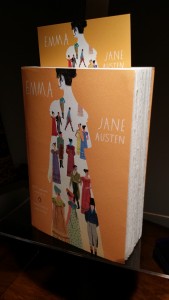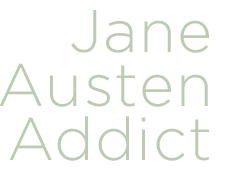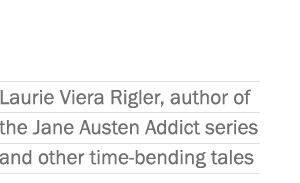 This luxurious new edition of EMMA features a series of pieces by Austen scholar and professor Juliette Wells, who informs us in her introduction that this is “a reader’s edition, not a scholarly one.” With the needs and wishes of her students in mind, Dr. Wells has included in this edition an abundance of extras that make EMMA’s world and its language as accessible as possible. There are tips for first-time readers of Austen, a series of short pieces that illuminate aspects of everyday life that Austen’s contemporaries would have taken for granted but which often elude today’s readers, a glossary of words that are now either obsolete or have evolved in meaning, plus maps, illustrations, and more.
This luxurious new edition of EMMA features a series of pieces by Austen scholar and professor Juliette Wells, who informs us in her introduction that this is “a reader’s edition, not a scholarly one.” With the needs and wishes of her students in mind, Dr. Wells has included in this edition an abundance of extras that make EMMA’s world and its language as accessible as possible. There are tips for first-time readers of Austen, a series of short pieces that illuminate aspects of everyday life that Austen’s contemporaries would have taken for granted but which often elude today’s readers, a glossary of words that are now either obsolete or have evolved in meaning, plus maps, illustrations, and more.
EMMA is a novel that, like all of Jane Austen’s major works, I have read at least twenty times. A great part of Austen’s genius is that there is always something new to be discovered in her novels, no matter how many times one reads them. Now, thanks to this lovely new edition, there is even more. For there is enough substance in this annotated edition to enlighten and entertain not only novice readers, but Austen devotees.
As an object of beauty, this book deserves high marks as well, with its eye-catching graphics that express both contemporary relevance and period authenticity, its textured, matte apricot-colored background, and its deckle-edged pages that remind us of the days when books had uncut pages to be opened by their first readers.
A conversation with JULIETTE WELLS, Editor and Introducer of EMMA: 200th-Anniversary Annotated Edition
(Penguin Classics Deluxe Edition; on-sale September 29, 2015; 9780143107712; $16.00)
When we celebrate the 200th anniversary of EMMA, what in particular are we celebrating? What’s new about this edition?
We’re celebrating the 200th anniversary of Emma’s original publication, in London in December, 1815. The date of publication is a little confusing because “1816” was printed on the title page of the first edition of the novel, but it was actually released in December, 1815. I think this gives us the right to celebrate for a whole year!
And what better way to celebrate than to re-read Emma, or read it for the first time? Our 200th-anniversary annotated edition has everything you need, all in one place, to help you appreciate this wonderful novel. You can immerse yourself in Austen’s world and also have, right at your fingertips, explanations of some of the elements of the novel that tend to trip up or puzzle today’s readers.
In the Austen canon, what would you say makes EMMA special and unique?
Emma is special because it’s the capstone of Austen’s career as an author. She had already published three novels (Sense and Sensibility, Pride and Prejudice, and Mansfield Park), and she was at the very top of her game as a writer. She didn’t know it, of course, but Emma would be the last book she saw through to publication. When Austen died in July 1817, she left two essentially completed novels (Northanger Abbey and Persuasion), which her brother published at the end of that year. So Emma is the last Austen novel that was published in the exact form that she herself approved.
Emma is also special because it’s the most perfect example of Austen’s particular genius as an author, which is (I think) to create a recognizable, engaging fictional world from the slenderest of materials. She writes about everyday life and ordinary people—you won’t find kings and queens in her novels, or ghosts or vampires. Her effects are wonderfully subtle.
What was the publishing process like when EMMA was first published? How was the novel received critically? Was Austen as popular in her own day as she is today?
The publishing process was recognizable in some ways and very different in others. Austen didn’t have a literary agent; at that time, authors dealt directly with publishers. With Emma, she chose a new, more prestigious publisher—John Murray—than she had used for her three earlier novels, and she negotiated hard for a good contract with him. As authors are today, Austen was responsible for proofreading and approving copy before publication. Since being a published author was considered not so respectable for an unmarried woman, Austen chose to remain anonymous on her title pages throughout her lifetime. Emma identifies her as “the author of Pride and Prejudice.” Her identity wasn’t made publicly known until after her death.
Like Austen’s earlier novels, Emma was praised by reviewers, who appreciated Austen’s ability to convey a very realistic fictional world. Austen wasn’t a bestseller in her day; then as now, thrillers, adventure stories, and romances outsold quiet literary fiction. But Austen did have the satisfaction of knowing, in her lifetime, that readers appreciated her work. In addition to reading reviews, she kept track of the responses of her friends and family, which offer a wonderful glimpse into what everyday readers of Austen’s own time thought of Emma. Some of what they liked and didn’t like may be very familiar to us!
One of your specialties as a professor of English is how Jane Austen’s work continues to appeal to people, how it remains at the forefront of pop culture conversation. Last year, Alexander McCall Smith updated EMMA, “Pride and Prejudice and Zombies” hits the big screen in 2016, and movie and TV versions of Austen continue to draw viewers. Why do you think we keep updating and adapting Austen? What are your favorite adaptations or updates, and what makes them successful?
Austen really is endlessly adaptable, much like Shakespeare! You can transpose her stories and her characters to other places and times, and they still work. My own favorite creation inspired by Austen is Amy Heckerling’s Clueless, from 1995. Clueless is a joy to experience, and smart too, much like an Austen novel.
I’m also a big fan of Sense and Sensibility, also from 1995, for which Emma Thompson wrote the screenplay. Experiencing Austen through the eyes of a witty, thoughtful contemporary woman—it doesn’t get any better than that! I like Karen Joy Fowler’s novel The Jane Austen Book Club, from 2004, for the same reason—an experienced writer chooses to think about how Austen’s works matter to us today, and takes us along for the ride. Lost in Austen, the British miniseries from 2008, is also a big favorite of mine. A rabid Austen fan finds her way into the world of Pride and Prejudice and messes it up. It’s a hoot to see the Austen characters we know so well doing and saying things that they NEVER would have done or said in the original novel.
I think TV and movie adaptations of Austen are so popular for two main reasons. They’re beautiful to watch, no question. And they offer a respite—which a lot of people of all ages value—from the loud, fast, scary, stuff that much of mainstream entertainment is these days. The tricky part comes, sometimes, when someone knows and loves Austen through the films and then goes to pick up one of the novels, only to discover that the reading experience is a lot more complex and challenging than the viewing experience. I had those first-time readers of Austen very much in mind when creating this new edition of Emma.
What is it like to prepare a new edition of a book that’s so well-known and exists in many editions? What kind of research did you do? Did anything you learned during the process surprise you?
It was really important to me to create a truly new approach to Emma—a welcoming, reader-friendly approach. Excellent editions of Emma already exist for scholars and for devoted “Janeites.” With this anniversary edition, I wanted to open Austen up to people who hadn’t given her a try before, and to support their reading experience by using everything I know from years of teaching undergraduates and from talking with everyday readers. I certainly reached for plenty of scholarly and reference sources on my shelves, but I’d say my most important preparation was to have built up, over time, a sense of what readers are curious about and what frustrates them in their first encounter with an Austen novel. And, through my teaching, I’ve had a lot of practice at explaining historical concepts in an accessible way.
I also had the huge pleasure of re-reading Emma myself, slowly, with pencil in hand, making lists of topics to cover in my contextual essays and marking words that would likely be unfamiliar to present-day Americans. By doing this, I developed a much deeper appreciation of Austen’s artistry with words. This surprised and delighted me—I would have said I appreciated her artistry plenty before! But it wasn’t until I was trying to figure out how to convey the meaning of a particular phrase that I realized how much meaning she packs in with her clever, economical word choices.
Thinking about readers’ experience with Emma also shaped how the contextual material is presented in this new edition. In my experience, many ordinary readers, and even college students too, are put off by footnotes, or at best ignore them. So we decided instead to group topics together in contextual essays, which are easier—and, I hope, more fun—to read. Here too my experience explaining historical concepts And, there’s no question, the gorgeous cover by Dadu Shin is a beautiful invitation to pick up this Emma!
The illustrations for this edition are drawn from historical copies of Emma in the Jane Austen Collection at Goucher College, where you teach. Can you tell us more about that collection? What is it, exactly?
The Jane Austen Collection at Goucher College in Baltimore, Maryland began as the passion project of an alumna of the college from the 1920s, Alberta Hirshheimer Burke. Alberta loved, loved, loved Jane Austen’s writings and decided that her own purpose in life was to gather as much material as possible relating to Austen. So Alberta bought first and rare editions and even some manuscripts—such as letters in Austen’s handwriting—all of which she felt brought her closer to her beloved author. The images in our new edition reproduce turn-of-the-twentieth century illustrations of Emma by English and American artists, from books that Alberta owned, and which she bequeathed to her alma mater when she died in 1975. (Her manuscripts went to the Pierpont Morgan Library in New York.)
Alberta also cared deeply about ephemera with an Austen connection, such as newspaper and magazine articles, which she preserved in ten overstuffed scrapbooks. So our Austen Collection at Goucher is a terrific resource for popular culture studies as well as book history.
As a college professor, what’s your favorite aspect of teaching Austen? Do you face any challenges in interesting students in her writings?
Absolutely the best part of teaching Austen is that so many students are enthusiastic about studying her writings. She is an easy sell! Shakespeare is the only other English writer who has a draw like hers. And Austen has the advantage that her life story as a woman writer is especially appealing. Many of my students are creative writers themselves and find Austen’s confidence and perseverance to be very inspiring.
That said, I do often encounter people—students and ordinary readers—for whom Austen just seems unappealing. Maybe her novels seem girly; maybe they seem awfully full of privileged white people (not untrue); maybe the sentences or paragraphs are just too long. Stephen King said recently in a New York Times Book Review that he had never read any Austen, and I feel it’s a real shame that a great writer like him has missed a great writer like her! Maybe I’ll have to send him this new Emma and see if he can get into it.
I love it that everyone who reads Jane Austen has her or his own ideas about what’s important and what’s interesting. Some readers gravitate towards her humor, while for others, the morality really resonates. Pretty much all of us can find at least one character who reminds us of someone we know—and we’re lucky if it’s a character who’s nice!
Do you think we have a modern-day equivalent of Jane Austen? Or do you have any “further reading” suggestions for Austen fans who’ve read all of her books a thousand times and are looking for something new?
I love to read contemporary novels and memoirs, and I always keep an eye out for hints that an author is influenced by or interested in Austen. I recently re-read Allegra Goodman’s novel The Cookbook Collector and really appreciated how she weaves in elements from Emma as well as from her more obvious place of inspiration, Sense and Sensibility. I also particularly like that Alison Bechdel, author of the graphic-format memoir Fun Home and the Dykes to Watch Out For comics, gives several shout-outs to Austen. Flyover Lives, Diane Johnson’s hybrid family history / memoir, includes a fascinating account of what Johnson’s foremothers in America were up to at the same time that Austen was writing about much more privileged women in England.
I’d also warmly recommend the novels of Barbara Pym, a 20th-century English writer. Pym’s dry humor and close observation of everyday people ally her very closely with Austen. And it’s always rewarding to read, or re-read, 19th-century novels by authors who knew and loved Austen’s writings. In that category, I’d especially recommend Elizabeth Gaskell (start with Cranford) and George Eliot (outside of Austen, Middlemarch is my all-time favorite novel).
And, finally, I’d say that Austen lovers are the best people to ask about what to read next! Lately, I’ve been hearing a lot of shout-outs for the novels of Anthony Trollope, so I may have to get cracking on his enormous oeuvre . . .


